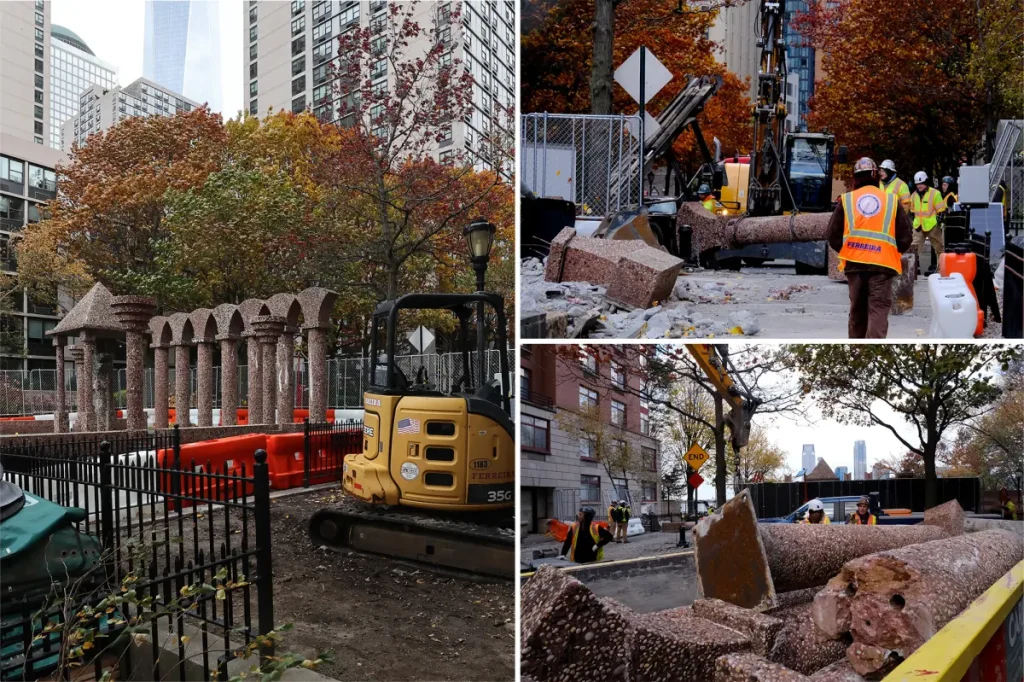The Fall of Upper Room: A Beloved Public Art Installation’s Controversial End
In a heart-wrenching development for the Battery Park City community, the iconic Upper Room sculpture was reduced to rubble last Thursday, ending its nearly four-decade presence as a cherished public gathering space. The 20-columned structure, which stood majestically at the Esplanade entrance at Albany Street, fell victim to demolition crews armed with jackhammers, saws, and backhoes, as part of the Battery Park City Authority’s controversial North/West Battery Park City Resiliency project. As the first public art piece ever commissioned by the Authority—valued at $1.5 million—its destruction has sparked intense debate about the balance between climate resilience planning and preserving cultural landmarks that define a community’s identity and history.
The demolition has left many local advocates bewildered and questioning the necessity of sacrificing this artistic treasure. John Dellaportas, Vice President of The Battery Alliance, voiced the community’s confusion: “There are a lot of people questioning why the art piece had to be destroyed. How they connect climate change to destroying a piece of public art on really high ground is beyond me.” This sentiment resonates with many residents who saw the Upper Room not merely as an art installation but as a living monument that had become intertwined with the neighborhood’s character and daily life. The abruptness with which a structure that took decades to become part of the community’s fabric was destroyed in just two days has left many feeling that an irreplaceable piece of local heritage has been needlessly sacrificed.
The Battery Park City Authority has defended its decision as an unavoidable consequence of their flood mitigation strategy. According to officials, the Upper Room occupied space critical for the construction of a large tide gate designed to protect the area from future flooding events similar to Superstorm Sandy. They further cited structural concerns, noting that the sculpture had begun showing signs of cracking in recent years and would have been challenging to relocate due to its reinforced construction, with columns filled with rebar. From the Authority’s perspective, the demolition represents a difficult but necessary sacrifice to ensure the long-term safety and resilience of the broader community—a classic case of weighing immediate cultural preservation against future disaster prevention in an era of increasing climate uncertainty.
However, this explanation has not satisfied critics, particularly those with expertise in art conservation. Melanie Brussat, a conservator previously hired by the BPCA to assess the Upper Room’s condition, offered a scathing assessment of the Authority’s decision-making process: “A sculpture like this costs more to move than to destroy, but the BPCA has a responsibility as the stewards of a public collection. The engineering firm that recommended destroying Upper Room is expert at overseeing resiliency projects, but doesn’t have extensive experience with public art pieces. The BPCA should have hired experts in moving and preserving art.” This criticism suggests that financial considerations, rather than technical impossibilities, may have played the decisive role in the sculpture’s fate—raising questions about how public authorities value cultural assets against their budgetary constraints.
The artist himself, 77-year-old Ned Smyth, shared this perspective, expressing his frustration that alternatives were not more thoroughly explored. Smyth revealed to The Post that he had proposed relocating the sculpture beyond BPCA property, but felt his suggestions fell on deaf ears: “They didn’t want to pay, is the bottom line. It’s all about money, I think, and to rebuild it, I’d need to recast all the parts of it again and reset them—they were set on real foundations.” His comments underscore the painful reality for many artists whose public works eventually face threats from changing urban priorities, development pressures, or, increasingly, climate adaptation measures. For Smyth, watching his creation—a work that had outlived countless changes in the neighborhood and survived previous natural disasters—destroyed for a future-focused project represents a profound professional loss.
The demolition of the Upper Room ultimately represents more than just the loss of a physical structure; it symbolizes the complex and often contentious decisions communities must make as they adapt to climate change realities. While the stormproof seawall may indeed provide critical protection for Battery Park City residents in the coming decades, the community has lost something intangible in the process—a gathering place, a landmark, and a piece of artistic heritage that connected generations of New Yorkers. As cities worldwide grapple with similar challenges, the story of the Upper Room serves as a poignant reminder that adaptation strategies must find ways to preserve cultural identity even as they transform physical spaces. For now, Battery Park City residents are left with memories and photographs of their beloved Upper Room, a place that, until very recently, stood as testimony to the power of public art to create meaning and community in urban environments.










